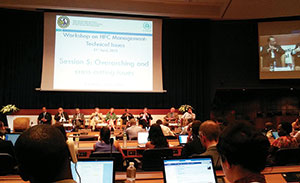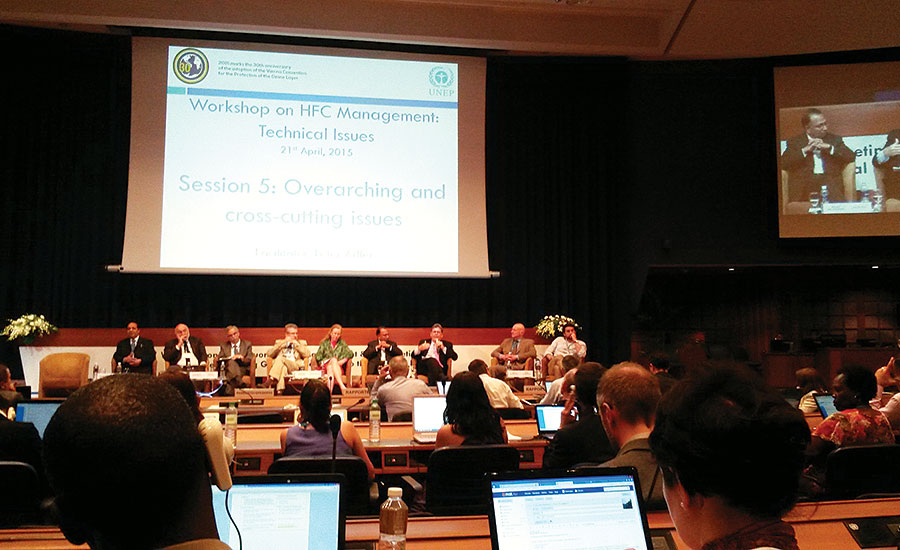
|
| HFC WORKSHOP: A workshop on HFC management recently took place in Bangkok. It was one step along the way to a Meeting of the Parties to the Montreal Protocol in Dubai later this year. Courtesy of the Alliance For Responsible Atmospheric Policy |
A revised Montreal Protocol is not out of the question in 2015. A workshop on hydrofluorocarbon (HFC) management and a meeting of the Open-Ended Working Group of the Parties to the Montreal Protocol took place in Bangkok in April, and another meeting is scheduled for Paris in July. All of the efforts are leading up to a full Meeting of the Parties to the Montreal Protocol this November in Dubai.
SIGNIFICANT PROGRESS
The HFC management workshop and Open-Ended Working Group meetings are an opportunity to present technical information relevant to HFCs, such as high-ambient temperature performance, safety requirements, and energy efficiency, and to provide a forum to discuss potential obstacles to an HFC phasedown.
According to Stephen Van Maren, director, Alliance for Responsible Atmospheric Policy, the HFC management workshop in Bangkok featured strong participation from voices representing various industry perspectives.
Many challenges, including adapting codes and standards to accommodate alternatives to high-GWP (global warming potential) HFCs, updating training and certification for the servicing sector to handle low-GWP alternatives, and the need for introducing life cycle climate performance assessments as a tool to understand the energy-efficiency impact on equipment were presented at the gathering.
The Open-Ended Working Group meeting was viewed as a step forward, albeit a small one, by many attendees. There continued to be concerns over a phasedown of HFCs expressed by several countries from the Gulf Cooperation Council, including Saudi Arabia, Kuwait, and Jordan, as well as Pakistan. Representatives from India, despite recently submitting an amendment proposal to join those from North America, the European Union, the Coalition of Pacific States, and a group of African countries, were largely silent during the meeting. In a new development, the U.S. explicitly expressed an openness to phase down proposals beyond the North American amendment.
On the transition from hydrochlorofluorocarbons (HCFCs), developing countries argued that conversion costs were not fully covered by the Multilateral Fund. Some developed country parties, including the U.S. and the E.U., offered their commitments to providing extra funds for the transition from HFCs.
As talks drew to a close, the parties broke for informal consultations and emerged with a list of concerns related to the implementation of a phasedown. The list will set the course for the discussions to take place in Paris and Dubai. Among the concerns are energy efficiency, funding requirements, safety of substitutes, availability of technologies, performance in high ambient temperatures, challenges to the production sector, rates of penetration of new alternatives, exemptions and ways to address lack of alternatives, and technology transfer.
INDUSTRY BENEFITS
Kevin Fay, executive director, Alliance for Responsible Atmospheric Policy, said if an international agreement is reached in Dubai, it would be a positive for the HVAC industry.
“Right now, we have an emerging patchwork of national and regional policies,” Fay said. “An international amendment would send the right signal to the market and tell companies what they should be putting their resources behind.”
Fay added that having a range of proposals under discussion is a healthy sign.
“Over the last few years, it has primarily been the North American proposal under discussion, but, now, there’s a real range of proposals, and that makes for a much healthier conversation about the possibilities,” said Fay. “It shows a level of engagement we haven’t had before. To have proposals from India, Micronesia, and the African countries is very healthy, because these discussions are often viewed as the divide between the developed countries and the developing.”
Fay noted that chemical companies and OEMs are putting forth a great deal of effort to create alternative refrigerants and applications that provide the performance desired, provide it with a level of efficiency that is as good or better than what currently exists, and provide it in a way that is also acceptable from an environmental performance standpoint.
“I think the real signal here is that HFCs have steadily moved into the position of being transitional chemicals,” Fay said. “Ten years ago, we would have hoped that would be the transitional chemical, and there wouldn’t be a need to further regulate them. But, because of GWP, they are now transitional chemicals as we try to meet the policy goal of being both ozone-safe and having a low GWP.”
He added the proposals under consideration have a range of phasedown schedules and most extend out 30-35 years. “The reason this treaty is considered to be the most effective multilateral environmental treaty ever negotiated is because it attempts to identify long-term objectives and does so in a way that allows the industry to achieve these objectives without short-term upheaval,” Fay said. “That’s why it works. It allows for an orderly transition and long-term planning.”
Karim Amrane, senior vice president of regulatory and international policy, Air-Conditioning, Heating, and Refrigeration Institute (AHRI), was in Bangkok as a member of an expert panel working with the U.S. Department of Energy (DOE)and the White House Council on Environmental Quality to oversee testing of low-GWP refrigerants at high ambient conditions.
“Everyone has different ideas of how to phase down the high-GWP refrigerants, but everyone is at least talking about the same thing: reducing the emissions and consumption of those refrigerants,” Amrane said. “That’s where we are in terms of international negotiations.”
Regardless of what happens internationally, Amrane added, the EPA has started the process in the U.S., and if its proposal to delist some high-GWP refrigerants on Jan. 1, 2016, is approved, the most significant impact will be felt in the commercial refrigeration sector.
Ultimately, Fay acknowledges there is still much work to be done to reach a new Montreal Protocol agreement in Dubai in November, but the HFC management workshops and Open-Ended Working Group meetings should help the process.
“We’ve expanded the understanding level a great deal, and the engagement by the developing countries is improving significantly, but it’s a political process, so it’s difficult to predict that we’ll get to a specific outcome,” he said. “It’s safe to say the transition into low-GWP compounds and technologies is starting to gather momentum, and the benefit of an agreement is to help it proceed in a more orderly fashion. An agreement would help eliminate a lot of confusion in the marketplace.”
SIDEBAR: Montreal Protocol — The Contracting Impact
What does the possibility of a new revision of the Montreal Protocol — specifically one that includes a phasedown of hydrofluorocarbons (HFCs) — mean for contractors?
Karim Amrane, senior vice president of regulatory and international policy, Air-Conditioning, Heating, and Refrigeration Institute (AHRI), said: “Eventually, contractors are going to have to deal with new refrigerants. The new refrigerants that are coming up perform differently than current refrigerants, and some of them are mildly flammable. But, that’s not going to happen in the next couple of years; it’s further down the road. The industry and AHRI will be working with contractors to educate them and ensure they’re trained and able to properly handle the new refrigerants.”
Kevin Fay, executive director, Alliance for Responsible Atmospheric Policy, stated: “The fact remains that most of the emissions of these compounds occur either during leaks, service, or disposal of the products they’re used in. So, from a practice and policy standpoint, there’s going to be a significant focus on improving service practices to help minimize leaks and service losses, as well as on recovery and end-of-life. We feel that’s an important message regardless of what refrigerant you’re using. There’s not a whole lot of benefit when any refrigerant leaks. That means the equipment doesn’t run efficiently or doesn’t run at all. There needs to be a real sea change in terms of the improvements in service practice, technology, and attitudes, and that will be a big part of the future discussion.”
Publication date: 7/6/2015
Want more HVAC industry news and information? Join The NEWS on Facebook, Twitter, and LinkedIn today!



Report Abusive Comment